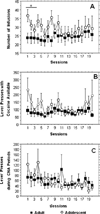Role of individual and developmental differences in voluntary cocaine intake in rats
- PMID: 21347641
- PMCID: PMC3187717
- DOI: 10.1007/s00213-011-2216-5
Role of individual and developmental differences in voluntary cocaine intake in rats
Abstract
Rationale: Early-onset drug taking is associated with increased likelihood of addiction, but it is unclear whether early onset is causal in development of addiction. Many other factors are associated with increased risk of addiction and also promote early intake. Here, a rodent model is used to explore the causality of early onset in development of self-administration and addiction-like behavior and to examine factors that promote self-administration.
Methods: We used cocaine self-administration to examine drug taking and addiction-like behavior in adolescent and adult rats a priori characterized for their locomotor responses to novelty and cocaine and behavior in the light-dark task.
Results: Adolescent animals initially sought more cocaine than adults. However, as the adolescents matured, their intake fell and they did not differ from adults in terms of unreinforced lever-pressing, extinction or reinstatement behavior. For both age groups, self-administration was positively correlated with the locomotor response to novelty, the locomotor response to cocaine, and with time in light in the light-dark task. The rats that were insensitive to cocaine's locomotor effects and that spent the least time in light in the light-dark task sought the least cocaine, appearing to be "protected" from the reinforcing effects of cocaine. There was no difference between the two age groups in appearance of this "protected" phenotype.
Conclusions: These results suggest that early onset of drug taking may promote increased use, but does not promote progression to addiction-like behavior. Furthermore, protective factors, such as innate anxiety and insensitivity to cocaine's pharmacological effects, function across developmental stages.
Figures





References
-
- Bell RL, Rodd ZA, Sable HJ, Schultz JA, Hsu CC, Lumeng L, Murphy JM, McBride WJ. Daily patterns of ethanol drinking in peri-adolescent and adult alcohol-preferring (P) rats. Pharmacol Biochem Behav. 2006;83:35–46. - PubMed
-
- Belluzzi JD, Wang R, Leslie FM. Acetaldehyde enhances acquisition of nicotine self-administration in adolescent rats. Neuropsychopharmacology. 2005;30:705–712. - PubMed
-
- Brown TL, Flory K, Lynam DR, Leukefeld C, Clayton RR. Comparing the developmental trajectories of marijuana use of African American and Caucasian adolescents: patterns, antecedents, and consequences. Exp Clin Psychopharmacol. 2004;12:47–56. - PubMed
Publication types
MeSH terms
Substances
Grants and funding
LinkOut - more resources
Full Text Sources
Medical

